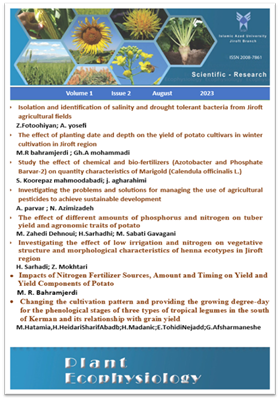Changing the cultivation pattern and providing the growing degree-day for the phenological stages of three types of tropical legumes in the south of Kerman and its relationship with grain yield
Subject Areas : Journal of plant ecophysiologyمحمد حاتمی 1 , حسین حیدری شریف آباد 2 * , حمید مدنی 3 , عنایت الله توحیدی نژاد 4 , غلامرضا افشارمنش 5
1 - گروه زراعت، واحد جیرفت، دانشگاه آزاد اسلامی، جیرفت، ایران
2 - گروه زراعت، واحد علوم و تحقیقات، دانشگاه آزاد اسلامی، تهران، ایران.
3 - گروه زراعت، واحد اراک، دانشگاه آزاد اسلامی، اراک، ایران.
4 - گروه زراعت و اصلاح نباتات، دانشگاه شهید باهنر، کرمان، ایران.
5 - گروه تحقیقات علوم زراعی و باغی، مرکز تحقیقات و آموزش کشاورزی و منابع طبیعی جنوب کرمان، AREEO، جیرفت، ایران
Keywords: Climate Change, cowpeas, Cultivation history, Tepari beans, Green mung beans,
Abstract :
In order to study the effect of changing the cultivation pattern in providing growth and development temperature in different phenological stages of three types of tropical legumes in the south of Kerman and to investigate the relationship between temperature and seed yield, a factorial experiment was conducted in the form of a randomized complete block design with three replications. It was implemented in Jiroft Agriculture and Natural Resources Research Center in 2019-2020. The experimental treatments included three planting dates, 30 Jan, 9 and 19 Feb, and three types of tropical legumes, including tepari or local Jiroft beans, cowpeas, and green mung beans. The results showed that the highest requirement for growth degree-days from planting to germination, from planting to greening and one to five leaf stages in all three planting dates was related to green mung bean. After mung beans, the highest need for growing degree-days in the above stages was observed in Tepari or Jiroft local beans and nightly beans, respectively. In the stages of flowering, pod formation and filling and ripening, the difference between mung beans and two types of beans in the number of degree-days of growth decreased. Although, the delay in planting in all three plants led to a decrease in the supply of growth degree-days from flowering to full maturity, but all three plants had more seed yield in the dates of cultivation than the common planting dates. So that mung bean had the same grain yield on all three planting dates with an average of 770 kg/ha. Tepari beans produced the highest yield in early cultivation, i.e. on 30 Jan, with an average of 2.3 tons per hectare. This legume was associated with a 39% decrease in seed yield on 9 and 19 Feb cultivation dates compared to the first cultivation date. Among the three tropical legumes, cowpea has the highest seed yield with an average of 4.6 tons per hectare and on 30 Jan and 19 Feb there was no difference in production and on the planting date of 9 Feb 26% decrease in seed yield was observed. In general, in the Jiroft region, the date of early winter crops, considering the provision of temperature and humidity necessary to complete the growth and development process and complete the phenological stages for tropical legumes, considering the negative effect of drought on the growth cycle of plants and also Their performance was completely superior to spring cultivation and this finding can be effective in managing the use of air temperature to reduce water consumption in the region.

